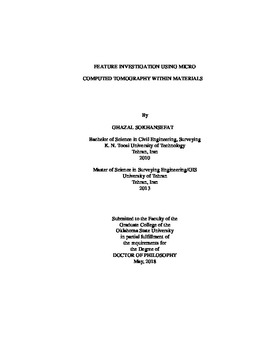| dc.contributor.advisor | Ley, Tyler | |
| dc.contributor.author | Sokhansefat, Ghazal | |
| dc.date.accessioned | 2019-03-25T21:13:42Z | |
| dc.date.available | 2019-03-25T21:13:42Z | |
| dc.date.issued | 2018-05 | |
| dc.identifier.uri | https://hdl.handle.net/11244/317728 | |
| dc.description.abstract | This work uses micro computed tomography, as a direct non-destructive tool, to investigate the internal 3D microstructure of different materials at multiple length scales to provide insights that are of interest to the scientific community on a variety of different problems. | |
| dc.description.abstract | In the first chapter, the 3D microstructure of three types of manufactured biomass microsphere particles was investigated before and after fast pyrolysis. The results show that the particle size, biomass components, and volume of air decrease during fast pyrolysis. | |
| dc.description.abstract | Next, concrete mixtures with different aggregate gradations and workability were prepared to study the aggregate packing in hardened concrete. The results show that low distance between aggregates and areas where no aggregates are observed correspond with mixtures of poor workability in the fresh concrete. These findings suggest that segregation of the coarse aggregate plays an important role in the workability of fresh concrete. | |
| dc.description.abstract | In addition, the role of critical degree of saturation and air void system on the crack propagation of cement mortar subjected to freeze-thaw cycles was investigated. The results show that cracking occurred in non-air entrained mortar subjected to a single freeze-thaw cycle when the critical degree of saturation was near 100%. These microcracks mostly initiate and propagate from the paste-aggregate interface or from within aggregate. In addition, materials were observed to form within the pores after freezing. | |
| dc.description.abstract | Finally, the role of air void system on the freeze-thaw damage of the cement paste was investigated. The results show that severe frost damage occurred in the surface of the non-air entrained cement paste ponded with KI solution after 63 freeze-thaw cycles. It was also observed that the average distance between air voids in the non-air-entrained was ~ 1.8x higher than the average distance between air voids in the air-entrained samples. In addition, most of the air voids (~75%) in both non-air-entrained and air-entrained samples are distributed in size ranges between 15 to 60 um. These observations show that X-ray imaging is a powerful method that provides new insights into physical properties and morphology of biomass particles, workability of flowable concrete, and freeze-thaw performance of concrete. | |
| dc.format | application/pdf | |
| dc.language | en_US | |
| dc.rights | Copyright is held by the author who has granted the Oklahoma State University Library the non-exclusive right to share this material in its institutional repository. Contact Digital Library Services at lib-dls@okstate.edu or 405-744-9161 for the permission policy on the use, reproduction or distribution of this material. | |
| dc.title | Feature investigation using micro computed tomography within materials | |
| dc.contributor.committeeMember | Hartell, Julie Ann | |
| dc.contributor.committeeMember | Cross, Stephen A. | |
| dc.contributor.committeeMember | Apblett, Allen | |
| osu.filename | Sokhansefat_okstate_0664D_15645.pdf | |
| osu.accesstype | Open Access | |
| dc.type.genre | Dissertation | |
| dc.type.material | Text | |
| thesis.degree.discipline | Civil Engineering | |
| thesis.degree.grantor | Oklahoma State University | |
